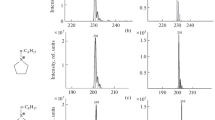Summary
The fragmentation of sixteen S-substituted N-acetyl(-l-)cysteine derivatives (mercapturic acids and methyl esters) was studied under collision induced dissociation (CID) conditions recording series of product (daughter) ion spectra. After transfer of the data from the MS data system to an external PC, a PASCAL computer program called PDNL (Parent — Daughter — Neutral Loss) was used a) to elucidate the structures of fragment ions by means of comparison with an MS/MS spectral library, b) to construct an MS/MS data domain, c) to eliminate consecutive decompositions, d) to evaluate the fragmentation pathways and e) to develop an MS/MS detector for mercapturic acids or their methyl esters. In this way common fragmentation reactions for mercapturic acids and their methyl esters could be ascertained. Selected reaction monitoring using a direct insertion probe was used to determine the concentration of 3-hydroxypropylmercapturic acid (compound 2) in human urine. The limit of detection was 50 ppb (signal-to-noise ratio=3:1) using 5 μl extracts from urine. This method was compared with a classical method for the quantitative determination of compound 2. The relative standard deviation and the coefficient of variation was specified for the MS/MS method.
Similar content being viewed by others
References
Moldeus P (1985) In: Siest G (ed) Drug metabolism, molecular approaches and pharmaceutical implications. Pergamon Press, Oxford, pp 69–73
Arias IM, Jacoby WB (ed) (1976) Glutathione, metabolism and function. Raven Press, New York
Knox JH, Jurand J (1977) J Chromatogr 142:651
Onkenhout W, Vermeulen NPE, Luijten WCMM, de Jong HJ (1983) Biomed Mass Spectrom 10:614–619
Pachinger A (1990) Diss Abstr Int B 51:739
Schlunegger UP (1980) Advanced mass spectrometry. Pergamon Press, Oxford, pp 55–107
Busch KL, Glish GL, McLuckey SA (ed) (1988) Mass spectrometry/mass spectrometry. VCH, New York, pp 1–13
Bray HG, Caygill JC, James SP, Wood PB (1964) Biochem J 90:127–132.
Barnsley EA (1966) Biochem J 100:362
Zbarsky SH, Young L (1943) J Biol Chem 151:211–215
Schoen AE, Amy JW, Ciupek JD, Cooks RG, Dobberstein P, Jung G (1985) Int J Mass Spectr Ion Proc 65:125–140
Gregg HR (1987) Diss Abstr Int B 48:730
Budzikiewicz H, Djerassi C, Williams DH (ed) (1967) Mass spectrometry of organic compounds. Holden-Day, San Francisco, pp 287–289
Schwarz JC, Wade AP, Enke CG, Cooks RG (1990) Anal Chem 62:1809–1818
Author information
Authors and Affiliations
Rights and permissions
About this article
Cite this article
Stanek, W., Hayek, E.W.H., Krenmayr, P. et al. Tandem mass spectrometric studies of mercapturic acid derivatives. Fresenius J Anal Chem 340, 201–206 (1991). https://doi.org/10.1007/BF00321768
Received:
Issue Date:
DOI: https://doi.org/10.1007/BF00321768




